SSANGYONG TURISMO 2013 Service Manual
Manufacturer: SSANGYONG, Model Year: 2013, Model line: TURISMO, Model: SSANGYONG TURISMO 2013Pages: 796, PDF Size: 78.99 MB
Page 771 of 796
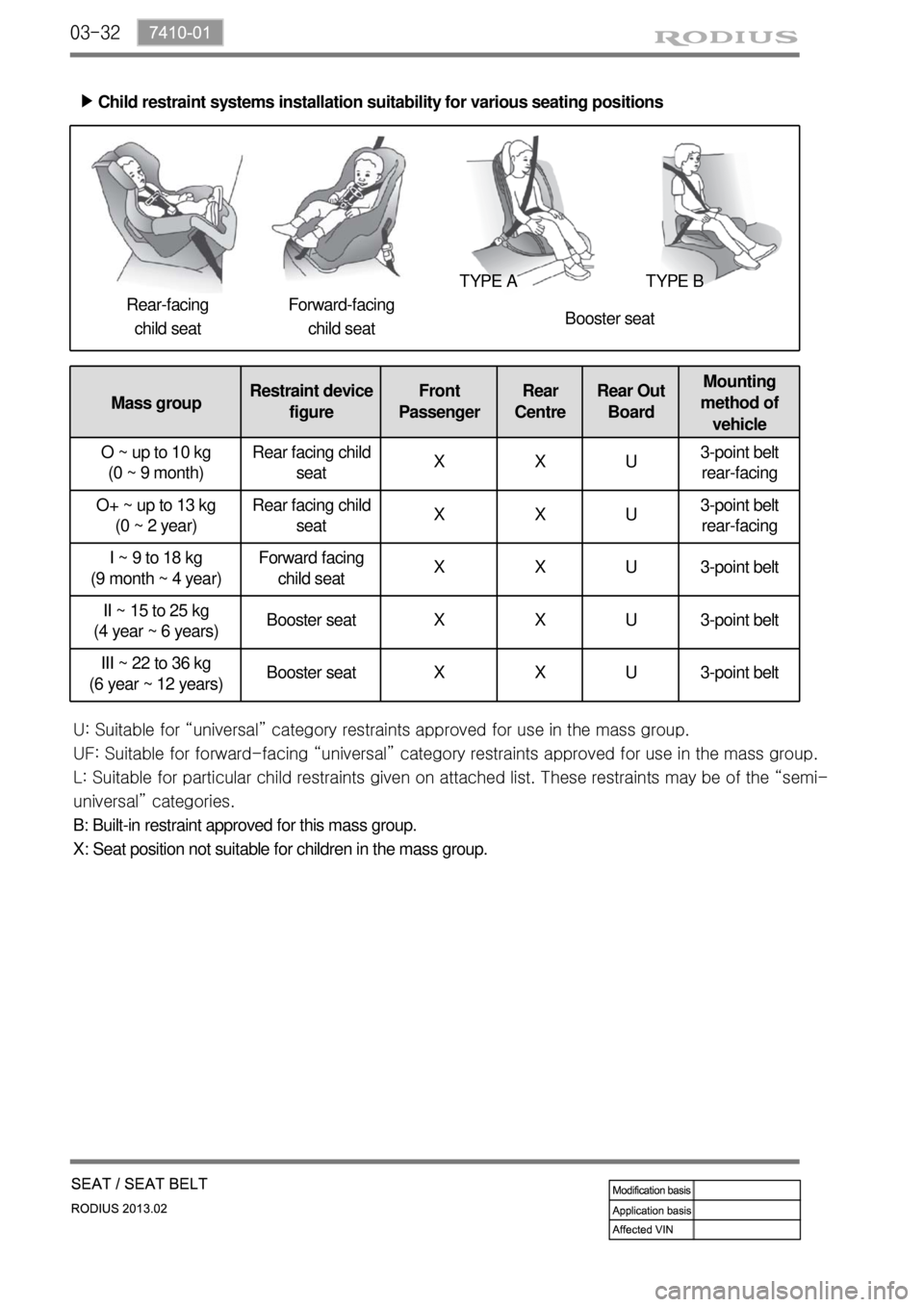
03-32
Child restraint systems installation suitability for various seating positions ▶
Forward-facing
child seat Rear-facing
child seatTYPE B TYPE A
Booster seat
Mass groupRestraint device
figureFront
PassengerRear
CentreRear Out
BoardMounting
method of
vehicle
O ~ up to 10 kg
(0 ~ 9 month)Rear facing child
seatXXU3-point belt
rear-facing
O+ ~ up to 13 kg
(0 ~ 2 year)Rear facing child
seatXXU3-point belt
rear-facing
I ~ 9 to 18 kg
(9 month ~ 4 year)Forward facing
child seatX X U 3-point belt
II ~ 15 to 25 kg
(4 year ~ 6 years)Booster seat X X U 3-point belt
III ~ 22 to 36 kg
(6 year ~ 12 years)Booster seat X X U 3-point belt
U: Suitable for “universal” category restraints approved for use in the mass group.
UF: Suitable for forward-facing “universal” category restraints approved for use in the mass group.
L: Suitable for
particular child restraints given on attached list. These restraints may be of the “semi-
universal” categories.
B: Built-in restraint approved for this mass group.
X: Seat position not suitable for children in the mass group.
Page 772 of 796
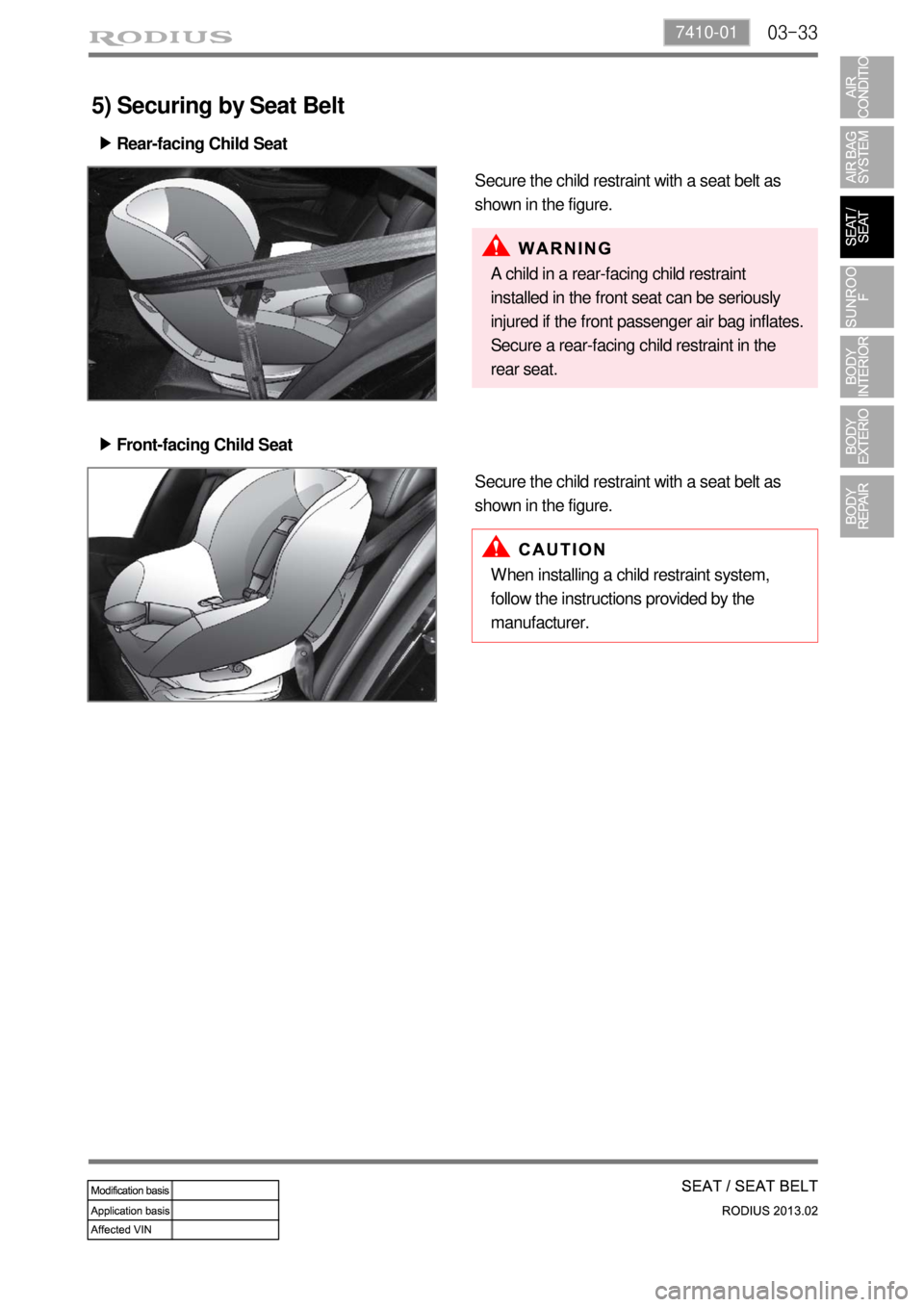
03-337410-01
5) Securing by Seat Belt
Front-facing Child Seat ▶
Secure the child restraint with a seat belt as
shown in the figure. Rear-facing Child Seat ▶
Secure the child restraint with a seat belt as
shown in the figure.
A child in a rear-facing child restraint
installed in the front seat can be seriously
injured if the front passenger air bag inflates.
Secure a rear-facing child restraint in the
rear seat.
When installing a child restraint system,
follow the instructions provided by the
manufacturer.
Page 773 of 796
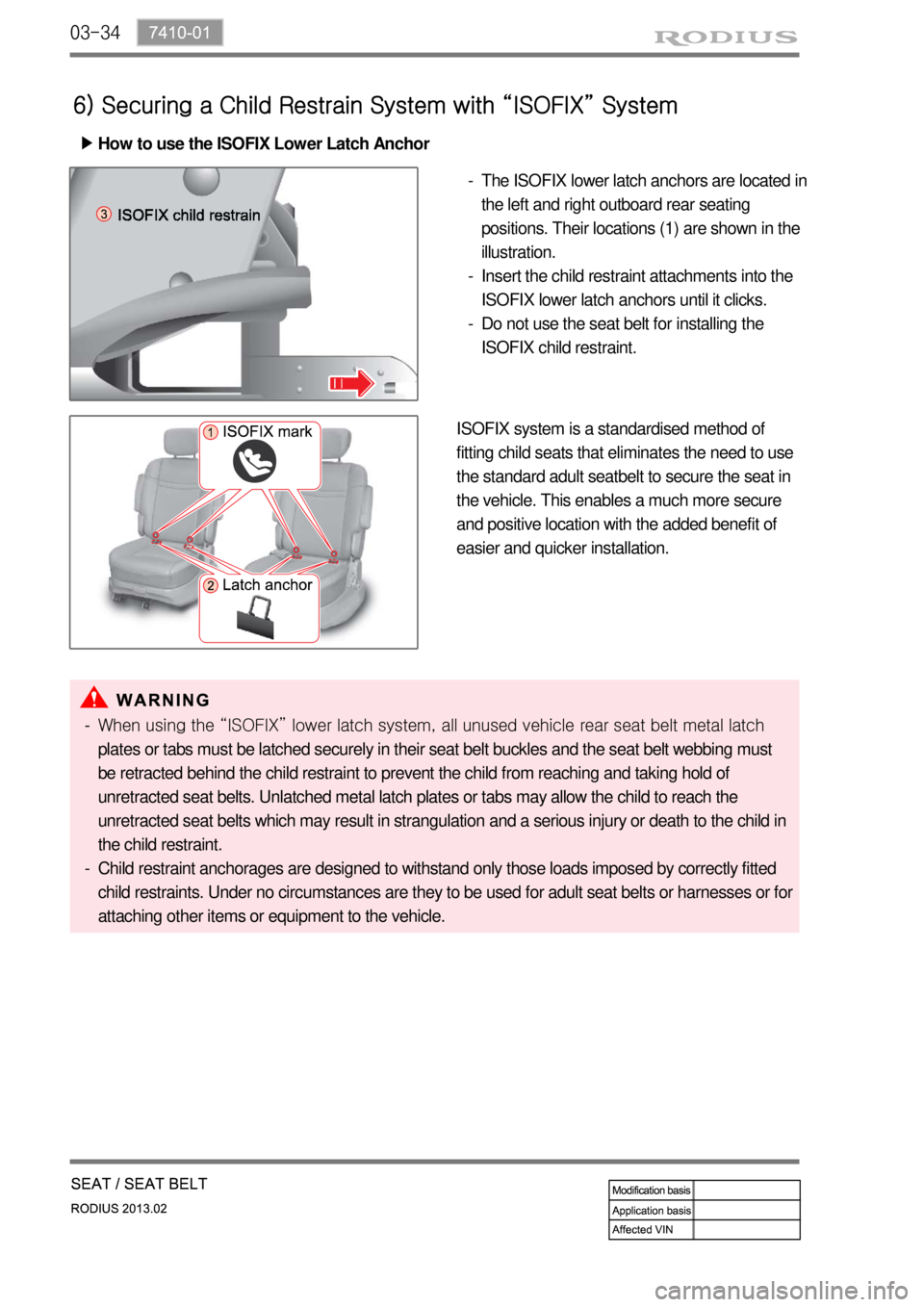
03-34
6) Securing a Child Restrain System with “ISOFIX” System
How to use the ISOFIX Lower Latch Anchor ▶
The ISOFIX lower latch anchors are located in
the left and right outboard rear seating
positions. Their locations (1) are shown in the
illustration.
Insert the child restraint attachments into the
ISOFIX lower latch anchors until it clicks.
Do not use the seat belt for installing the
ISOFIX child restraint. -
-
-
ISOFIX system is a standardised method of
fitting child seats that eliminates the need to use
the standard adult seatbelt to secure the seat in
the vehicle. This enables a much more secure
and positive location with the added benefit of
easier and quicker installation.
When using the “ISOFIX” lower latch system, all unused vehicle rear seat belt metal latch
plates or tabs must be latched securely in their seat belt buckles and the seat belt webbing must
be retracted behind the child restraint to prevent the child from reaching and taking hold of
unretracted seat belts. Unlatched metal latch plates or tabs may allow the child to reach the
unretracted seat belts which may result in strangulation and a serious injury or death to the child in
the child restraint.
Child restraint anchorages are designed to withstand only those loads imposed by correctly fitted
child restraints. Under no circumstances are they to be used for adult seat belts or harnesses or for
attaching other items or equipment to the vehicle. -
-
Page 774 of 796

03-357410-01
How to use the Top Tether ▶
The top tether anchors for securing the child
seat are located on the back side of second
row seat.
Remove the headrest from the second row
seat.
Place the child restraint on the second row
seat.
Connect the tether connector in child
restraint to the rear anchor. Securely tighten
the child restraint by adjusting the webbing of
the tether connector. -
-
-
-
The rear anchor is the supplemental device to secure the child restraint system after engaging it
by the lower latches. Therefore, do not secure the child restraint system only with the seatback
anchors. The increased load may cause the hooks or anchors to break, causing serious injury or
death.
If a child restraint is not properly secured to the vehicle and a child is not properly restrained in
the child restraint, the child could be seriously injured or killed in a collision. Always follow the
instructions provided by the manufacturer for installation.
Make sure the latches of the child restraint system are latched to the lower latches. In this case,
you can hear the “click” sound.
Incorrectly installed child restraint system may cause an unexpected personal injury.
Child restraint anchorages are designed to withstand only those loads imposed by correctly fitted
child restraints.
The tether strap may not work properly if attached somewhere other than the correct rear
anchor.
Rock the child restraint to check if it is securely installed. Refer to instructions provided by the
manufacturer of the child restraint.
Do not install the child restraint if it hinders the operations of front seat. -
-
-
-
-
-
-
-
Page 775 of 796
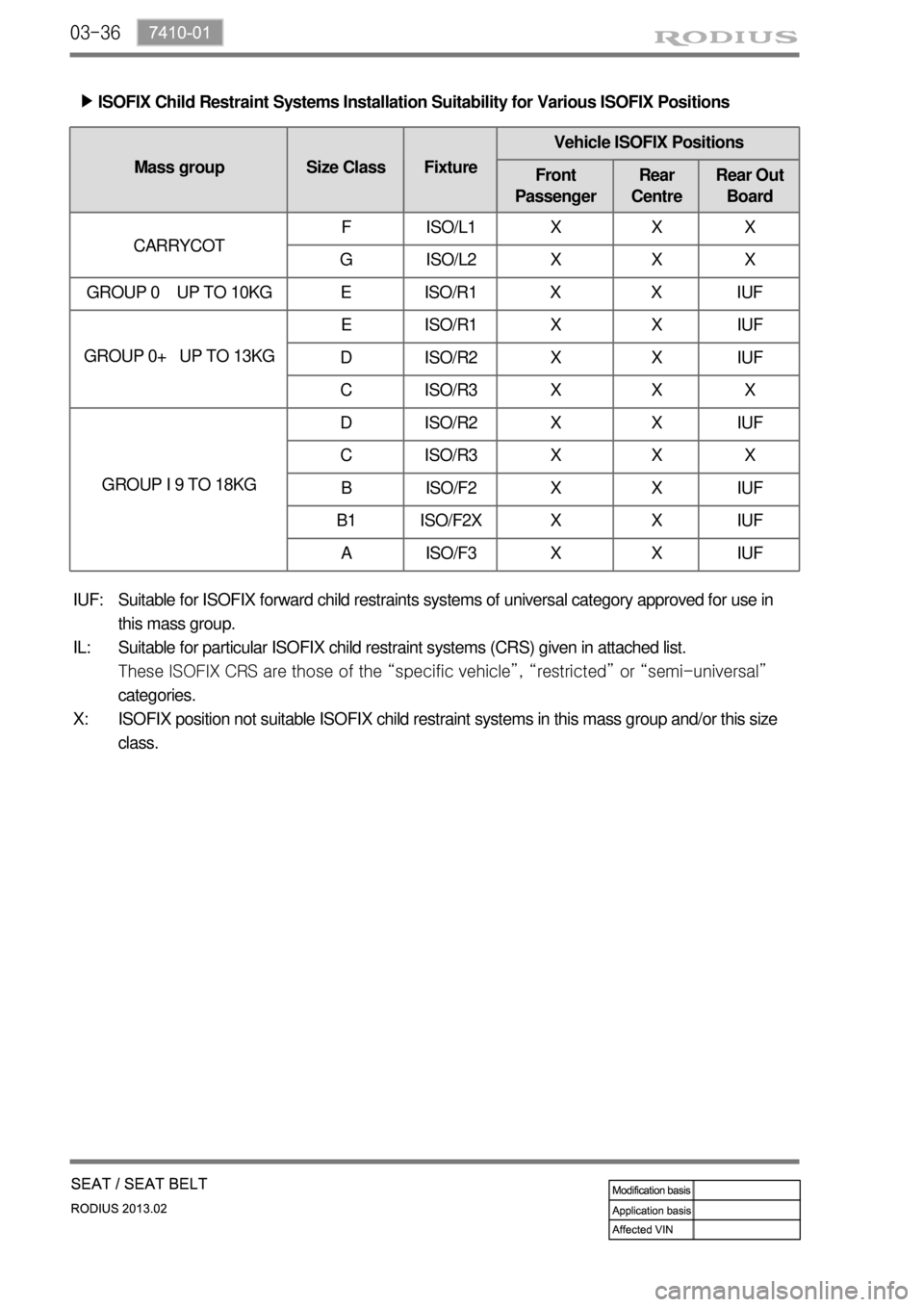
03-36
ISOFIX Child Restraint Systems Installation Suitability for Various ISOFIX Positions ▶
Mass group Size Class FixtureVehicle ISOFIX Positions
Front
PassengerRear
CentreRear Out
Board
CARRYCOTF ISO/L1 X X X
G ISO/L2 X X X
GROUP 0 UP TO 10KG E ISO/R1 X X IUF
GROUP 0+ UP TO 13KGE ISO/R1 X X IUF
D ISO/R2 X X IUF
C ISO/R3 X X X
GROUP I 9 TO 18KGD ISO/R2 X X IUF
C ISO/R3 X X X
B ISO/F2 X X IUF
B1 ISO/F2X X X IUF
A ISO/F3 X X IUF
Suitable for ISOFIX forward child restraints systems of universal category approved for use in
this mass group.
Suitable for particular ISOFIX child restraint systems (CRS) given in attached list.
These ISOFIX CRS are those of the “specific vehicle”, “restricted” or “semi-universal”
categories.
ISOFIX position not suitable ISOFIX child restraint systems in this mass group and/or this size
class. IUF:
IL:
X:
Page 776 of 796

03-377410-01
7) Warning For Child Restraint
Use only the officially approved child restraint.
Ssangyong is not responsible for the personal injury and property damage due to the defect of child
restraint.
Use only the child restraint with proper type and size for your baby.
Use only the child restraint at proper location.
Child restraint has 5 categories based on the weight as below:
GROUP 0: 0 ~ 10KG
GROUP 0+: 0 ~ 13KG
GROUP I: 9 ~ 18KG
GROUP II: 15 ~ 25KG
GROUP III: 22 ~ 36KG
Group 0 & 0+
Rear facing child restraint fitted on the rear seat
Group I
Forward facing child restraint fitted on the rear seat
Group II & III
Booster seat fitted on the rear seat with seat belt fastened
Always follow the installation and use instructions provided by the manufacturer of the booster seat. -
-
-
-
-
-
-
Page 777 of 796

03-38
Driver power seat ▶
7. CIRCUIT DIAGRAM
Page 778 of 796
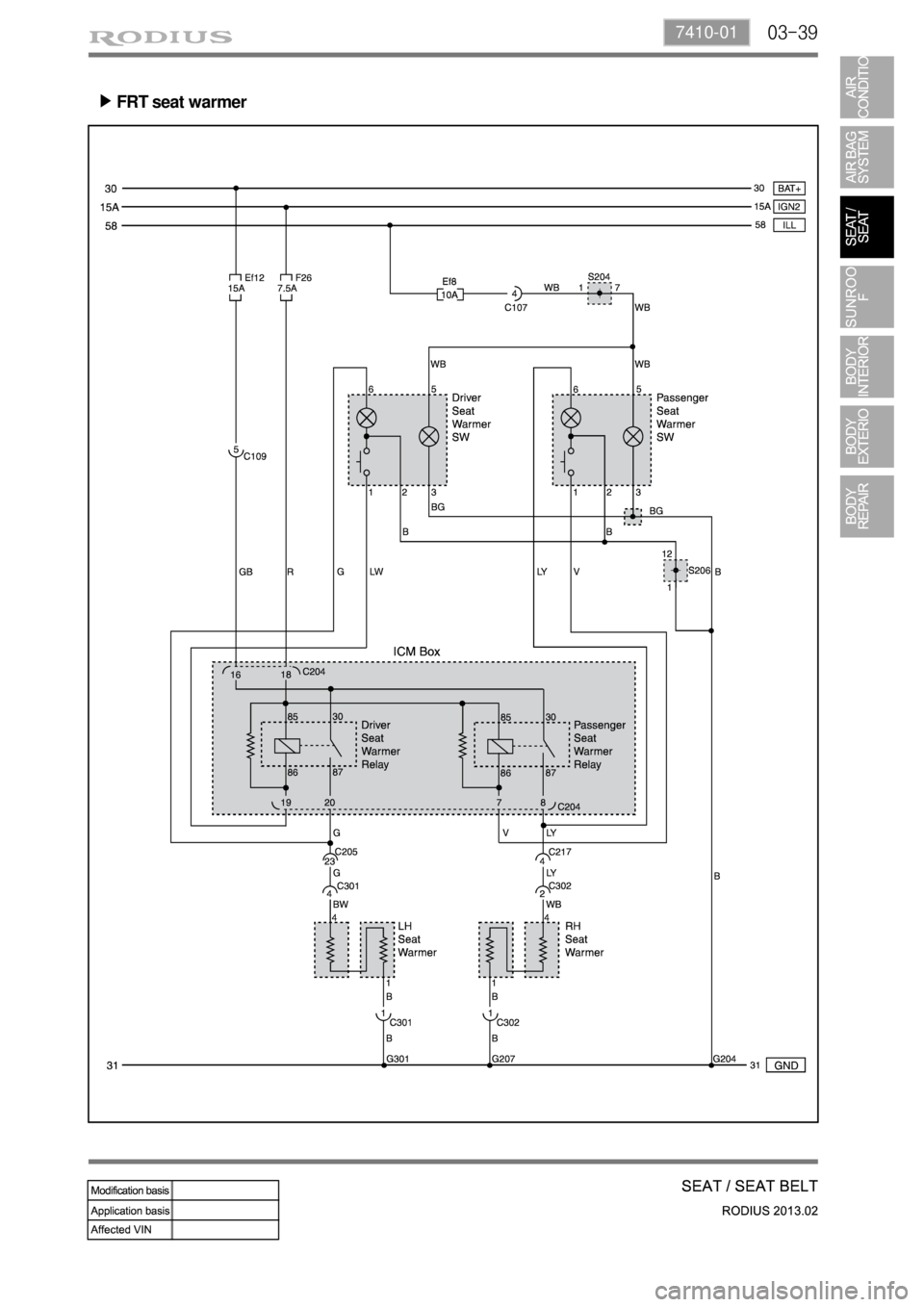
03-397410-01
FRT seat warmer ▶
Page 779 of 796

04-37340-00
1. SPECIFICATIONS
Item Specification Details
Operating voltage 9 ~ 16 V
Stand by currentMax. 125 mA IGN ON
Max. 3 mA Sleep mode
Load current6 A Normal operation
25 A Max. load current
Operating temperature-30 ~ 85℃
Storage temperature-40 ~ 90℃
Operating timeOpen, close: max. 9 sec
Open, close: max. 15 sec-20℃
Tilt: max. 1.5 sec
Tilt: max. 4 sec-20℃
Glass open level1st step sliding open: 326 ± 5 mm
2nd step sliding open: 376 ± 5 mm
Tilt up & open: 43.5 ± 3 mm
Glass thickness4 ± 0.2 mm
Displacement 2L / min
Page 780 of 796

04-4
2. CAUTIONS WHEN WORKING
Wear clean work clothes and gloves.
Any unauthorized modification or operational test is not allowed since the sunroof motor and control
unit are preset at the factory.
Pay attention not to drop the sunroof assembly when removing it and do not keep it right up. -
-
-
Even though the sunroof can be operated when the engine is not running, operating the sunroof
repeatedly with the engine turned off will run down the battery. Operate the sunroof while the engine
is running.
When the sunroof operation is completed, release the switch. Keeping pressing the switch can result
in malfunction.
Especially in winter, never operate the sunroof if operation areas are iced. Wait until melted.
To prevent a theft, make sure that the sunroof is completely closed when leaving the vehicle. In
addition, rain or snow can get into the vehicle through the open sunroof.
When the sunroof is fully open, wind buffeting symptom can be worse. In this case, try to adjust the
sunroof position manually or open the sunroof until the wind buffeting is disappeared
Parts of the body can be trapped in the sunroof and can be struck by passing objects. Do not stick
hands, head or anything else out of the openings.
Remove any dirt and foreign material stuck on the edge of the sunroof glass periodically. -
-
-
-
-
-
-
4. MAJOR CHANGES
Sunroof drain rear hose
Sunroof drain rear hose route changed due to rear quarter panel change
3. CAUTIONS FOR OPERATION